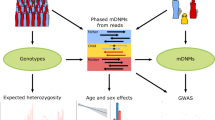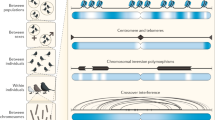Abstract
Although microsatellite polymorphisms are one of the most commonly used tools in genetic analyses1,2,3, it remains to be understood how microsatellite DNA has evolved as a ubiquitous and highly abundant class of repetitive sequences in eukaryotic genomes4. On the basis of analyses of spontaneous human microsatellite mutations of germline origin, I show here that different mutation biases underlie the evolution of microsatellite repeats. The within-locus mutation rate increases with allele length, but is not affected by the size difference between an individual's two alleles (allele span). Within loci, long alleles tend to mutate to shorter lengths, thereby acting to prevent infinite growth. Expansions are more common than contractions among dinucleotide repeats, whereas no such trend is evident among tetranucleotide repeats. This observation is consistent with the longer repeat lengths and higher frequency of di- compared with tetranucleotide repeats. An excess of paternally transmitted mutations (male-to-female ratio of 4.9) supports a male-biased mutation rate in the human genome.
This is a preview of subscription content, access via your institution
Access options
Subscribe to this journal
Receive 12 print issues and online access
$209.00 per year
only $17.42 per issue
Buy this article
- Purchase on SpringerLink
- Instant access to full article PDF
Prices may be subject to local taxes which are calculated during checkout




Similar content being viewed by others
References
Bowcock, A.M. et al. High resolution of human evolutionary trees with polymorphic microsatellites. Nature 368, 455–457 (1994).
Dib, C. et al. A comprehensive genetic map of the human genome based on 5,264 microsatellites. Nature 380, 152–154 (1996).
Ellegren, H., Lindgren, G., Primmer, C.R. & Møller, A.P. Fitness loss and germline mutations in barn swallows breeding in Chernobyl. Nature 389, 393–396 (1997).
Hamada, H., Petrino, M.G. & Kakunaga, T. A novel repeated element with Z-DNA-forming potential is widely found in evolutionarily diverse eukaryotic genomes. Proc. Natl Acad. Sci. USA 79, 6465–6469 (1982).
Kimura, M. The Neutral Theory of Molecular Evolution (Cambridge University Press, Cambridge, 1983).
Weber, J.L. & Wong, C. Mutation of human short tandem repeats. Hum. Mol. Genet. 2, 1123–1128 (1993).
Brinkmann, B., Klintschar, M., Neuhuber, F., Hühne, J. & Rolf, B. Mutation rate in human microsatellites: influence of the structure and length of the tandem repeat. Am. J. Hum. Genet. 62, 1408–1415 (1998).
Primmer, C.R., Ellegren, H., Saino, N. & Møller, A.P. Directional evolution in germline microsatellite mutations. Nature Genet. 13, 391–393 (1996).
Farrall, M. & Weeks, D.E. Mutational mechanisms for generating microsatellite allele-frequency distributions: an analysis of 4,558 markers. Am. J. Hum. Genet. 62, 1260–1262 (1998).
Weber, J.L. Informativeness of human (dC-dA)n·(dG-dT)n polymorphisms. Genomics 7, 524–530 (1990).
Rubinsztein, D.C. et al. Microsatellite evolution-evidence for directionality and variation in rate between species. Nature Genet. 10, 337–343 (1995).
Amos, W., Sawcer, S.J., Feakes, R.W. & Rubinsztein, D.C. Microsatellites show mutational bias and heterozygote instability. Nature Genet. 13, 390–391 (1996).
Ellegren, H., Primmer, C.R. & Sheldon, B.C. Microsatellite evolution: directionality or bias? Nature Genet. 11, 360–362 (1995).
Schlotterer, C. & Tautz, D. Slippage synthesis of simple sequence DNA. Nucleic Acids Res. 20, 211–215 (1992).
Chakraborty, R., Kimmel, M., Stivers, D.N., Davison, L.J. & Deka, R. Relative mutation rates at di-, tri-, and tetranucleotide microsatellite loci. Proc. Natl Acad. Sci. USA 94, 1041–1046 (1997).
Jones, A.G., Rosenqvist, G., Berglund, A. & Avise, J.C. Clustered microsatellite mutations in the pipefish Syngnathus typhle. Genetics 152, 1057–1063 (1999).
Primmer, C.R., Saino, N., Møller, A.P. & Ellegren, H. Unravelling the process of microsatellite evolution through analysis of germline mutations in barn swallows. Mol. Biol. Evol. 15, 1047–1054 (1998).
Wierdl, M., Dominska, M. & Petes, T.D. Microsatellite instability in yeast: dependence on the length of the microsatellite. Genetics 146, 769–779 (1997).
Hurst, L.D. & Ellegren, H. Sex biases in the mutation rate. Trends Genet. 14, 446–452 (1998).
Miyata, T., Hayashida, H., Kuma, K., Mitsuyasa, K. & Yasunaga, T. Male-driven molecular evolution: a model and nucleotide sequence analysis. Cold Spring Harb. Symp. Quant. Biol. 52, 863–867 (1987).
Shimmin, L.C., Chang, B.H.J. & Li, W.-H. Male-driven evolution of DNA sequences. Nature 362, 745–747 (1993).
McVean, G.T. & Hurst, L.D. Evidence for a selectively favourable reduction in the mutation rate of the X-chromosome. Nature 386, 388–392 (1997).
Crow, J.F. Molecular evolution—who is in the driver's seat? Nature Genet. 17, 129–130 (1997).
Ellegren, H. & Fridolfsson, A.K. Male-driven evolution of DNA sequences in birds. Nature Genet. 17, 182–184 (1997).
Vogel, F. & Motulsky, A.G. Human Genetics (Springer, Berlin, 1997).
Crow, J.F. The high spontaneous mutation rate: is it a health risk? Proc. Natl Acad. Sci. USA 94, 8380–8386 (1997).
Smith, N.G. & Hurst, L.D. The causes of synonymous rate variation in the rodent genome. Can substitution rates be used to estimate the sex bias in mutation rate? Genetics 152, 661–673 (1999).
El-Maarri, O. et al. Methylation at selected CpG sites in the Factor VIII and FGFR3 genes, in mature female and male germ cells: implications for male-driven evolution. Am. J. Hum. Genet. 63, 1001–1008 (1998)
Banchs, I. et al. New alleles at microsatellite loci in CEPH families mainly arise from somatic mutations in the lymphoblastoid cell lines. Hum. Mutat. 3, 365–372 (1994).
Farber, R.A., Petes, T.D., Dominska, M., Hudgens, S. & Liskay, R.M. Instability of simple sequences in a mammalian cell line. Hum. Mol. Genet. 3, 253–256 (1994).
Acknowledgements
I thank B. Sheldon for discussions and comments on the manuscript, and P. Gunn, B. Rolf and P. Stapleton for data on microsatellite mutations. Financial support was obtained from the Swedish Research Councils for Agriculture and Forestry, for Natural Sciences and for Medicine.
Author information
Authors and Affiliations
Corresponding author
Rights and permissions
About this article
Cite this article
Ellegren, H. Heterogeneous mutation processes in human microsatellite DNA sequences. Nat Genet 24, 400–402 (2000). https://doi.org/10.1038/74249
Received:
Accepted:
Issue Date:
DOI: https://doi.org/10.1038/74249
This article is cited by
-
LUSTR: a new customizable tool for calling genome-wide germline and somatic short tandem repeat variants
BMC Genomics (2024)
-
Localized assembly for long reads enables genome-wide analysis of repetitive regions at single-base resolution in human genomes
Human Genomics (2023)
-
Androgenetic/biparental mosaicism in a diploid mole-like conceptus: report of a case with triple paternal contribution
Virchows Archiv (2023)
-
Genome-wide identification and characterization of functionally relevant microsatellite markers from transcription factor genes of Tea (Camellia sinensis (L.) O. Kuntze)
Scientific Reports (2022)
-
Genome-wide characterization of microsatellite DNA in fishes: survey and analysis of their abundance and frequency in genome-specific regions
BMC Genomics (2021)



